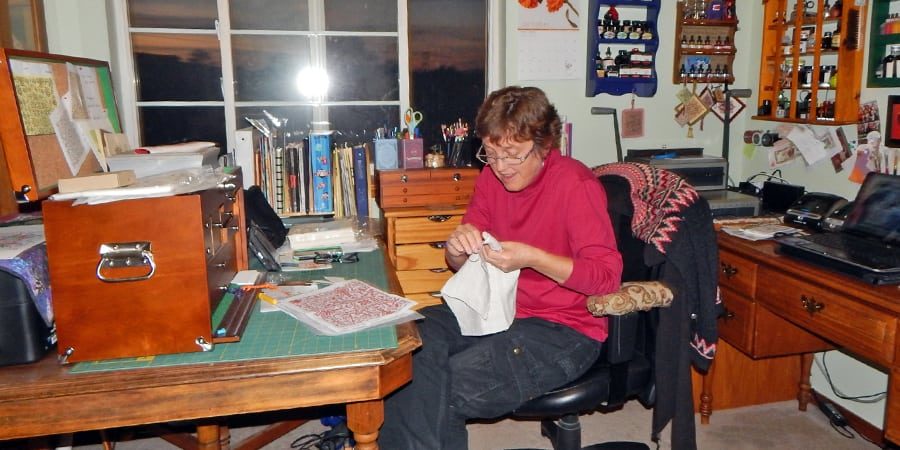
Home » Talented West Richland woman designs in cross-stitch
Talented West Richland woman designs in cross-stitch

December 24, 2015
Tracy Horner of West Richland creates artistic patterns by linking together tiny x-shaped stiches. Horner creates patterns for counted cross-stitch, a type of hand needlework that uses only small x-shaped stitches to create intricate designs. Counted cross-stitch is done on evenweave fabrics, which have the small number of horizontal and vertical threads in each inch. Eleven to 40 threads per inch is typical.
[blockquote quote="“Only a handful of designers in the U.S. can make a living at it. But I enjoy it. You have to do it for the love of the art." source="Tracy Horner" align="right" max_width="300px"]
Counted cross-stitch designs are printed on graph paper and the person doing the needlework must count the threads and stitch one x across every two threads in the fabric. “It’s just simple math,” said Horner. She’s been creating counted cross-stitch designs for nearly a decade and selling them under her business name, Ink Circles. You can see Horner’s counted cross-stitch designs on her website, www.inkcircles.com.
Horner didn’t set out to create counted cross-stitch designs as a business. She has a degree in electrical engineering and works for a Hanford company. “It began with me designing patterns for myself. Then some of my friends asked if they could make a project using my design. Soon I was marketing them on the internet and to needlework shops,” she said. Horner doesn’t expect her designs will make her rich.
“Only a handful of designers in the U.S. can make a living at it. But I enjoy it. You have to do it for the love of the art,” she said. To create a design that she can sell takes several months, she said. First she draws the design out on a measured grid on her computer using an application called Pattern Maker. “Doing this on a computer makes it a lot easier than by hand on paper,” she said. “It’s easier to make changes with a mouse than it is with an eraser, and if I want to repeat a portion of the design I just cut and paste.”
Once Horner’s satisfied with her design, she prints it out. That’s when the real test begins as she actually stitches her design onto fabric using colorful silk embroidery threads. Later she’ll photograph the completed project and have the photograph printed on card stock. That, and a printed copy of the chart showing the pattern becomes what she sells and markets to needlework shops across the nation, into Canada and around the world.
So far, Horner estimates she’s created more than 150 counted cross-stitch patterns. She makes 15 to 20 new patterns each year. For ideas, she just sits at her computer and begins doodling. “They just seem to grow under my fingers,” Horner said. Horner’s been doing needlecraft work since she was in grade school. Horner’s mother ran a needlework shop out of their home when she was growing up in Wyoming and Nevada. “In fact, both my parents enjoy embroidery. Dad specializes in a type of embroidery that looks almost like a painting when he’s done. Depending on the size they can take months to complete,” Horner said. Her father prefers to embroider wolves, she said. “Wolves running, wolves sleeping, wolves playing. If it’s wolves, he’s likely done it,” she said.
Her mother’s tastes are more eclectic. “She doesn’t have any one style or theme,” Horner said. Horner’s tastes run to very symmetrical patterns, the type she designs.
“I tend to use only a few colors in my counted cross-stitch designs. I save the rainbow for my mandala designs,” Horner said. Her mandalas — intricately drawn abstract designs — are created in pen and ink then colored in with felt tip markers, colored pencils or water colors. “I have a treasure trove of drawing instruments and supplies,” she said, pulling open a drawer crammed with colored pencils and pens.
Horner draws the mandalas freehand. “I like the look of them rather than those produced on a computer. They have a more organic feel,” she said. Recently coloring books for adults have appeared on the market. Instead of cartoon figures as children’s coloring books do, they have designs very similar to Horner’s mandalas.
“That’s where I got the idea to create my own adult coloring book and try marketing it. Amazon is interested in carrying it. I hope to have it ready in early November, in time for Christmas,” she said. She calls it Peace of Art because she finds coloring her mandalas calming and soothing. “You can’t be stressed out when you’re creating art,” Horner said.
Topics Local News Arts & Culture
KEYWORDS november 2015





